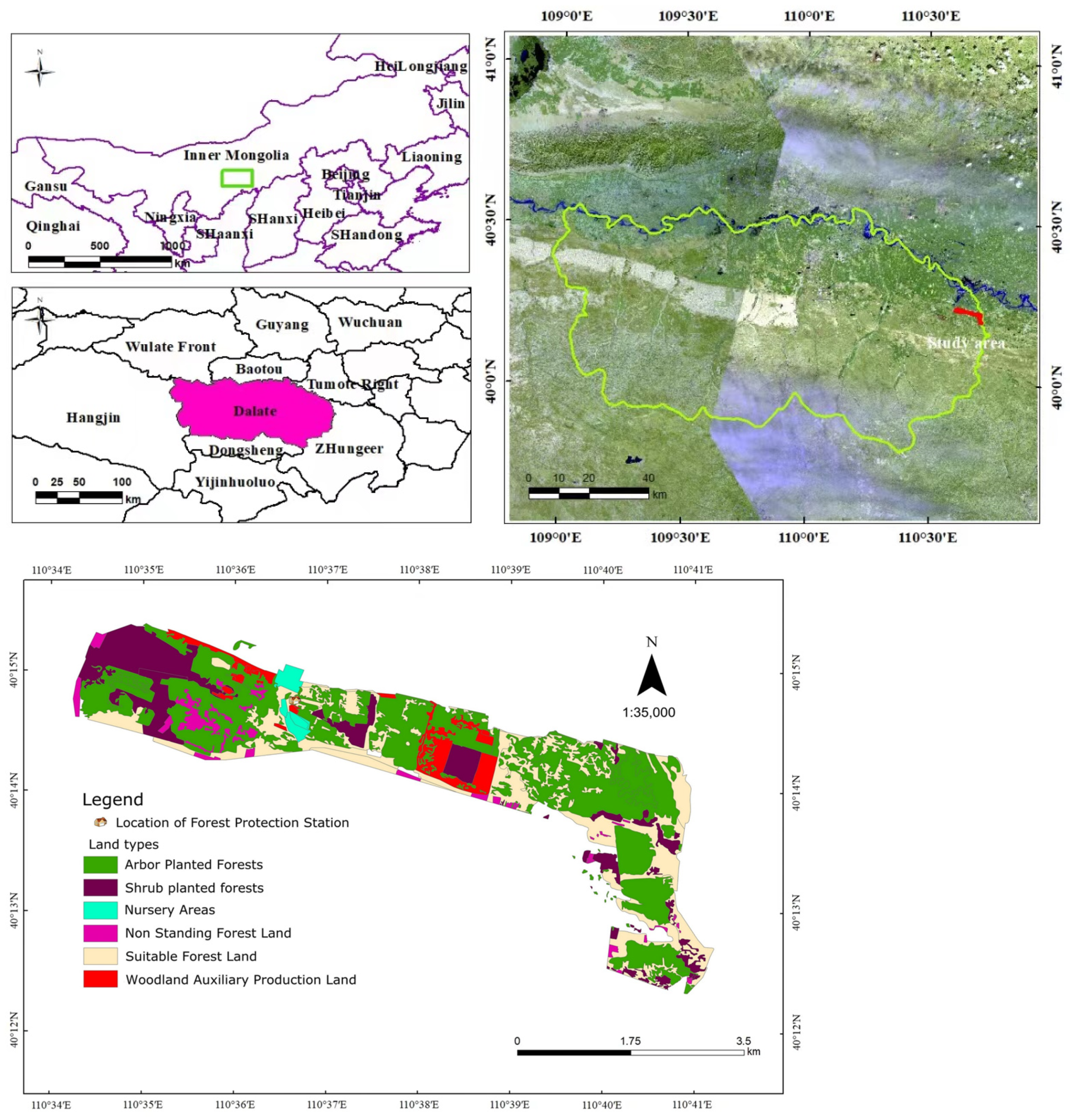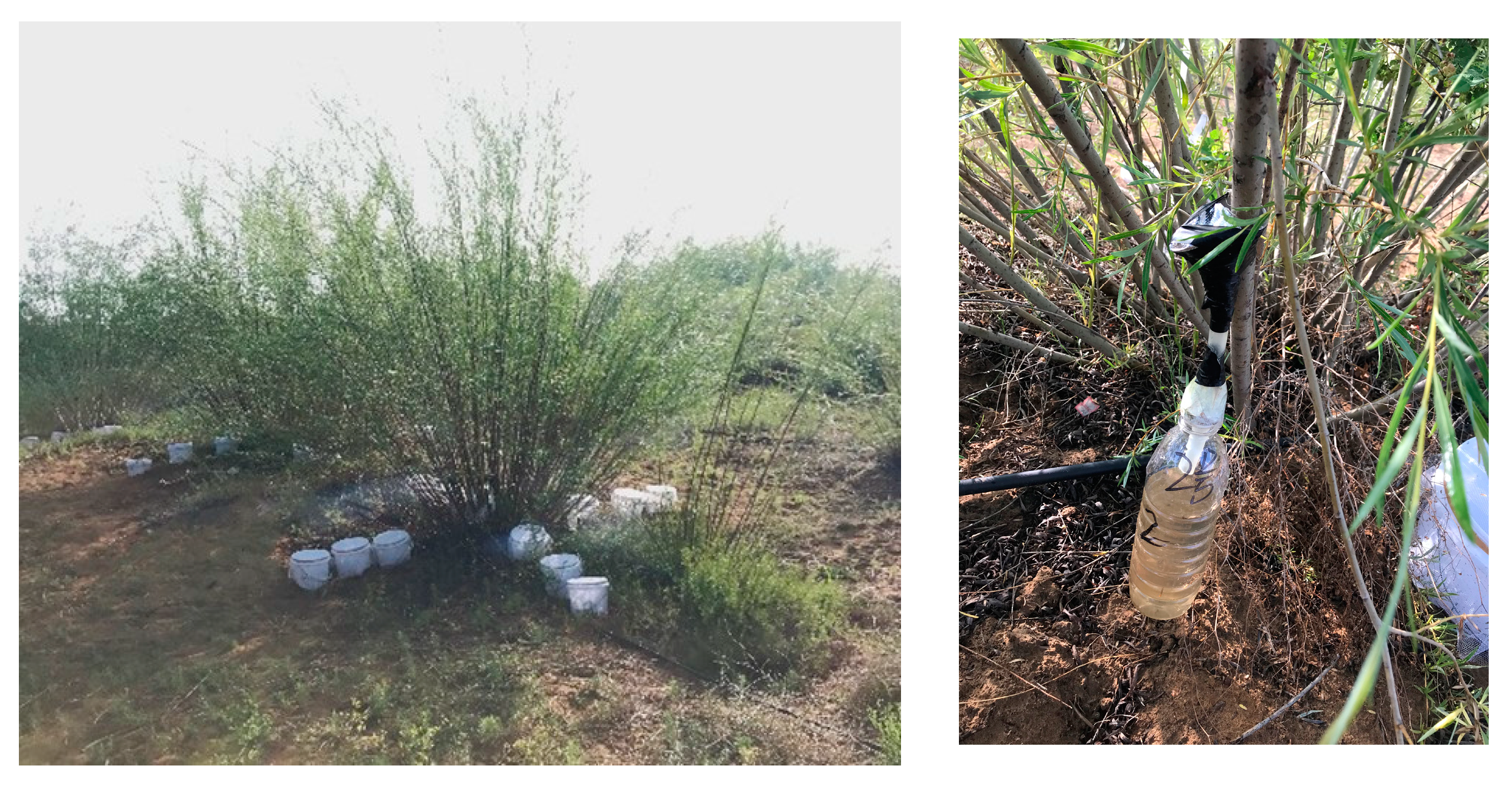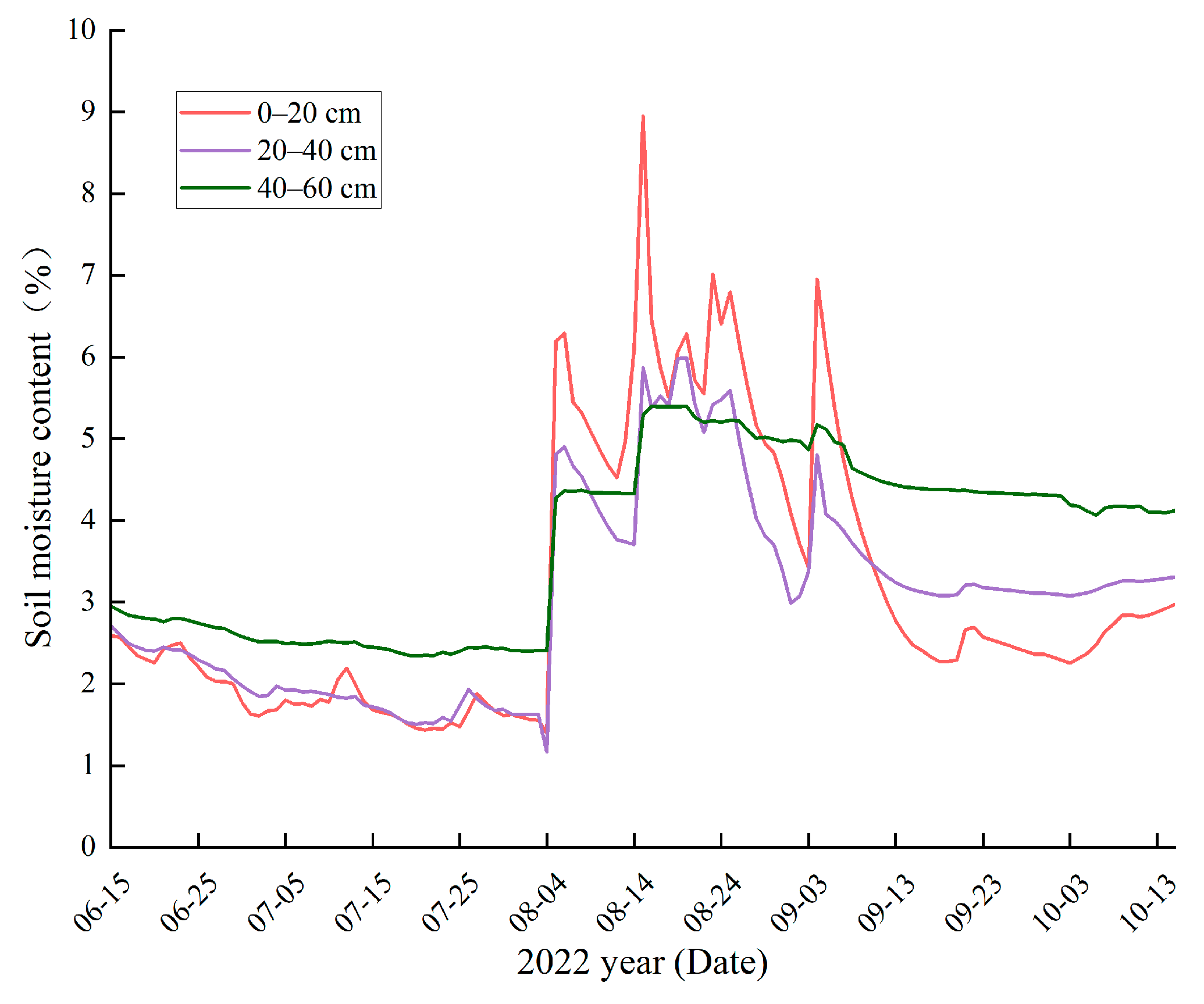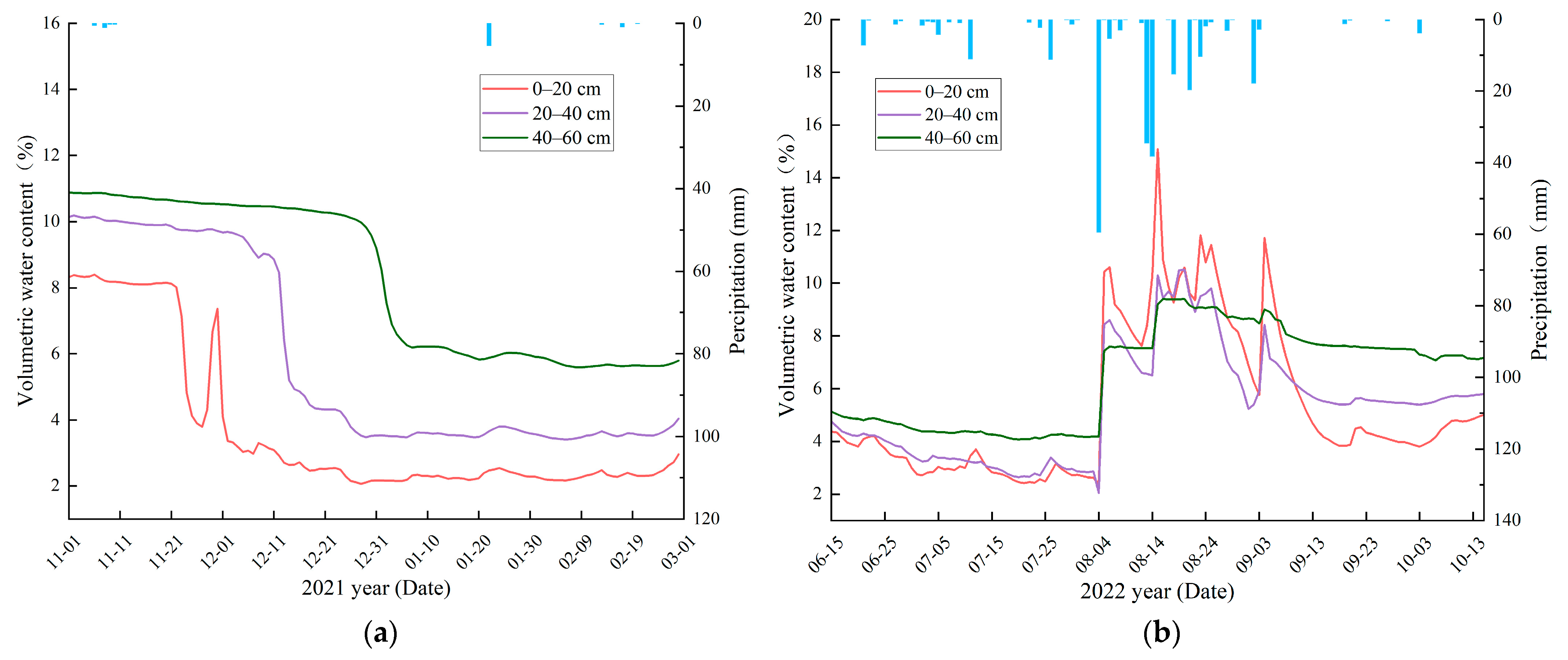Water Balance Characteristics of the Salix Shelterbelt in the Kubuqi Desert
Abstract
:1. Introduction
2. Materials and Methods
2.1. Study Area
2.2. Plot Setting and Investigation
2.3. Determination of Meteorological Factors
2.4. Measurement of Throughfall and Stemflow in the Forest and Calculation of Canopy Interception
2.5. Measurement of Trunk Sap Flow and Calculation of Stand Transpiration
2.6. Understory Evapotranspiration and Community Evapotranspiration
2.7. Determination of Soil Hydrological Characteristics and Calculation of Water Storage Capacity
2.8. Water Balance and Yield Calculations for the Sample Plots
3. Results
3.1. Characteristics of Rainfall Changes in the Salix Shelterbelt
3.1.1. Rainfall Redistribution Characteristics in the Salix Shelterbelt in Different Months
3.1.2. Effects of Rainfall in Forests on Rainfall Redistribution
3.2. Transpiration Variation Characteristics of the Salix Shelterbelt
3.3. Characteristics of Understory Evapotranspiration and Community Evapotranspiration in the Salix Shelterbelt
3.4. Soil Moisture Characteristics of the Salix Shelterbelt
3.5. Water Balance and Runoff Characteristics of the Salix Shelterbelt
4. Discussion
4.1. Analysis of Forestland Precipitation Redistribution Characteristics
4.2. Analysis of Forestland Transpiration and Understory Evapotranspiration
4.3. Analysis of the Total Evapotranspiration and Components of Salix
4.4. Soil Water Storage Change Characteristics
4.5. Shelterbelt Water Balance and Runoff Impact
5. Conclusions
- According to this research, the Salix forest in the Kubuqi Desert is basically in a state of water balance during the growing season, and the forestland has made a positive contribution to improving the desert climate and water conservation.
- In the future, appropriate irrigation treatments can be applied in June and July to meet the needs of healthier Salix forest growth.
Author Contributions
Funding
Data Availability Statement
Conflicts of Interest
References
- Cui, X.H.; Que, X.E.; Yang, L. Current status and thoughts on international standardization in the field of mitigating land degradation and combating desertification. Sci. Soil Water Conserv. 2020, 18, 147–152. [Google Scholar] [CrossRef]
- Schwärzel, K.; Zhang, L.; Montanarella, L.; Wang, Y.; Sun, G. How afforestation affects the water cycle in drylands: A process-based comparative analysis. Glob. Chang. Biol. 2020, 26, 944–959. [Google Scholar] [CrossRef]
- Shen, Q.; Gao, G.; Fu, B.; Lü, Y. Responses of shelterbelt stand transpiration to drought and groundwater variations in an arid inland river basin of Northwest China. J. Hydrol. 2015, 531, 738–748. [Google Scholar] [CrossRef]
- Naithani, K.J.; Ewers, B.E.; Pendall, E. Sap flux-scaled transpiration and stomatal conductance response to soil and atmos pheric drought in a semi-arid sagebrush ecosystem. J. Hydrol. 2012, 464–465, 176–185. [Google Scholar] [CrossRef]
- Du, A.P.; Yu, P.T.; Wang, Y.H.; Yuan, Y.X.; Guo, M.C.; He, C.Q.; Guan, W. The soil physical characteristics in the small watershed of Diediegou located on the north side of Liupan Mountains. For. Res. 2006, 19, 547–554. [Google Scholar]
- Li, M.Y.; Zhang, J.J.; Wang, C.X. Effects of land use types on soil physical properties in Loess Plateau of Western Shanxi. J. Soil Water Conserv. 2013, 27, 125–130. [Google Scholar]
- Qian, D. Transpiration Characteristics and Water Balance of a Mixed Shrubland in Mu Us Desert. Ph.D. Thesis, Beijing Forestry University, Beijing, China, 2016. [Google Scholar]
- Liu, W.H.; Wang, X.; Duan, W.B.; Yu, P.T.; Wang, Y.H. Water balance characters of Pinus tabuliformis plantation in Xining city of China. Sci. Silvae Sin. 2023, 59, 46–56. [Google Scholar]
- Dugas, W.A.; Hicks, R.A.; Gibbens, R.P. Structure and function of C3 and C4 Chihuahuan Desert plant communities. Energy balance components. J. Arid Environ. 1996, 34, 63–79. [Google Scholar] [CrossRef]
- Barbour, M.M.; Hunt, J.E.; Walcroft, A.S.; Rogers, G.N.D.; McSeveny, T.M.; Whitehead, D. Components of ecosystem evaporation in a temperate coniferous rainforest, with canopy transpiration scaled using sapwood density. New Phytol. 2005, 165, 549–558. [Google Scholar] [CrossRef]
- Batra, N.; Islam, S.; Venturini, V.; Bisht, G.; Jiang, L. Estimation and comparison of evapotranspiration from MODIS and AVHRR sensors for clear sky days over the Southern Great Plains. Remote Sens. Environ. 2006, 103, 1–15. [Google Scholar] [CrossRef]
- Scott, R.L.; Huxman, T.E.; Williams, D.G.; Goodrich, D.C. Ecohydrological impacts of woody-plant encroachment: Seasonal patterns of water and carbon dioxide exchange within a semiarid riparian environment. Glob. Chang. Biol. 2006, 12, 311–324. [Google Scholar] [CrossRef]
- Kurc, S.A.; Small, E.E. Dynamics of evapotranspiration in semiarid grassland and shrubland ecosystems during the summer monsoon season, central New Mexico. Water Resour. Res. 2004, 40, W09305. [Google Scholar] [CrossRef]
- Zhang, S.; Yu, P.; Wang, Y.; Zhang, H.; Valentina, K.; Huang, S.; Xiong, W.; Xu, L. Estimation of actual evapotranspiration and its components in the upper reaches of the Jinghe River. Acta Geogr. Sin. 2011, 66, 385–395. [Google Scholar]
- Vincke, C.; Thiry, Y. Water table is a relevant source for water uptake by a scots pine (Pinus sylvestris L.) stand: Evidences from continuous evapotranspiration and water table monitoring. Agric. For. Meteorol. 2008, 148, 1419–1432. [Google Scholar] [CrossRef]
- Joffre, R.; Rambal, S. How Tree Cover Influences the Water Balance of Mediterranean Rangelands. Ecology 1993, 74, 570–582. [Google Scholar] [CrossRef]
- Gerten, D.; Schaphoff, S.; Haberlandt, U.; Lucht, W.; Sitch, S. Terrestrial vegetation and water balance—Hydrological evaluation of a dynamic global vegetation model. J. Hydrol. 2004, 286, 249–270. [Google Scholar] [CrossRef]
- Shawn, M.C.; Solomon, Z.D.; Greenberg, J.A. Changes in climatic water balance drive downhill shifts in plant species’ optimum elevations. Science 2011, 331, 324–327. [Google Scholar]
- Dai, J. Application of SWAT Model in the Study of Water Balance of Forest and Grass Systems in Red Soil Hilly Areas in Northeastern Jiangxi. Master’s Thesis, Huazhong Agricultural University, Wuhan, China, 2004. [Google Scholar]
- Yu, X.; Zhang, J. Analysis and evaluation of soil water conditions of protective forest ecosystems in loess areas. For. Sci. 1996, 4, 289–297. [Google Scholar]
- Li, Y. Research on Characteristics of Typical Plantations and Soil Moisture Dynamics in the Loess Area of Western Shanxi. Ph.D. Thesis, Beijing Forestry University, Beijing, China, 2021. [Google Scholar] [CrossRef]
- Tao, J.L. Thinking and prospect of “three-north” shelterbelt system project. For. Sci. Technol. Inf. 2020, 52, 95–96. [Google Scholar]
- Levia, D.F.; Germer, S. A review of stemflow generation dynamics and stemflow-environment interactions in forests and shrublands. Rev. Geophys. 2015, 53, 673–714. [Google Scholar] [CrossRef]
- Lindroth, A.; Cermak, J.; Kucera, J.; Cienciala, E.; Eckersten, H. Sap flow by the heat-balance method applied to small-size salix trees in a short-rotation forest. Biomass Bioenergy 1995, 8, 7–15. [Google Scholar] [CrossRef]
- Cermak, J.; Kucera, J.; Nadezhdina, N. Sap flow measurements with some thermodynamic methods, flow integration within trees and scaling up from sample trees to entire forest stands. Trees 2004, 18, 529–546. [Google Scholar] [CrossRef]
- Ji, X.; Zhao, W.; Kang, E.; Jin, B.; Xu, S. Transpiration from three dominant shrub species in a desert-oasis ecotone of arid regions of Northwestern China. Hydrol. Process. 2016, 30, 4841–4854. [Google Scholar] [CrossRef]
- Duan, L.M.; Tong, X.; Lyu, Y. Upscaling of the transpiration and water consumption of sand-fixing vegetation Salix gordejevii and Caragana microphylla. J. Nat. Resour. 2018, 33, 52–62. [Google Scholar]
- Boast, C.W.; Robertson, T.M. A “micro-lysimeter” method for determining evaporation from bare soil: Description and laboratory evaluation. Soil Sci. Soc. Am. J. 1982, 46, 689–696. [Google Scholar] [CrossRef]
- Walker, G.K. Evaporation from wet soil surfaces beneath plant canopies. Agric. For. Meteorol. 1984, 33, 259–264. [Google Scholar] [CrossRef]
- Wei, N.N.; Mu, Y.M.; Jiang, X.Y.; Jia, X.; Gao, S.J.; Jiang, Y.; Jin, C.; Han, C.; Zha, T.S. Partitioning of evapotranspiration and the influencing factors of evapotranspiration components in a shrub ecosystem dominated by Artemisia ordosica and Hedysarum fruticosum var. mongolicum in the Mu Us Desert, Northwest China. Ying Yong Sheng Tai Xue Bao 2021, 32, 2407–2414. [Google Scholar] [CrossRef] [PubMed]
- Ma, L.L.; Du, L.T.; Dan, Y.; Wang, L.; Qiao, C.L.; Wu, H.Y. Characteristics of evapotranspiration in planted shrub communities in desert steppe zone based on sap flow and lysimeter methods. Chin. J. Plant Ecol. 2022, 44, 807. [Google Scholar] [CrossRef]
- Crockford, R.H.; Richardson, D.P. Partitioning of rainfall into throughfall, stemflow and interception: Effect of forest type, ground cover and climate. Hydrol. Process. 2000, 14, 2903–2920. [Google Scholar] [CrossRef]
- Cuartas, L.A.; Tomasella, J.; Nobre, A.D.; Hodnett, M.G.; Waterloo, M.J.; Múnera, J.C. Interception water-partitioning dynamics for a pristine rainforest in Central Amazonia: Marked differences between normal and dry years. Agric. For. Meteorol. 2007, 145, 69–83. [Google Scholar] [CrossRef]
- Gash, J.H.C.; Wright, I.R.; Lloyd, C.R. Comparative estimates of interception loss from three coniferous forests in Great Britain. J. Hydrol. 1980, 48, 89–105. [Google Scholar] [CrossRef]
- Chang, M. Forest Hydrology: An Introduction to Water And Forests; CRC Press: Boca Raton, FL, USA, 2006. [Google Scholar]
- Levia, D.F.; Frost, E.E. A review and evaluation of stemflow literature in the hydrologic and biogeochemical cycles of forested and agricultural ecosystems. J. Hydrol. 2003, 274, 1–29. [Google Scholar] [CrossRef]
- Llorens, P.; Domingo, F. Rainfall partitioning by vegetation under Mediterranean conditions: A review of studies in Europe. J. Hydrol. 2007, 335, 37–54. [Google Scholar] [CrossRef]
- Cheng, R.R. Eco-hydrological Processes in Two Typical Natural Forests and Artificial Forests in the Loess Hilly Region of China. Ph.D. Thesis, University of Chinese Academy of Sciences, Beijing, China, 2020. [Google Scholar] [CrossRef]
- Li, C.X.; Ouyang, Z.Y.; Zheng, H.; Liu, X.L.; Su, Y.M. Comparison of Rainfall Redistribution in Two Ecosystems in Minjiang Upper Catchments, China. J. Plant Ecol. 2006, 30, 723–731. [Google Scholar]
- Gerrits, M.J.; Pfister, L.; Savenije, H.H.G. Spatial and temporal variability of canopy and forest floor interception in a beech forest. Hydrol. Process. 2010, 24, 3011–3025. [Google Scholar] [CrossRef]
- Dang, H.Z.; Dong, T.S.; Zhao, Y.S. Study on Canopy Interception of Fraxinus mandshurica. For. Res. 2008, 21, 657–661. [Google Scholar]
- Lagergren, F.; Lindroth, A. Transpiration response to soil moisture in pine and spruce trees in Sweden. Agric. For. Meteorol. 2002, 112, 67–85. [Google Scholar] [CrossRef]
- Li, W.; Si, J.H.; Feng, Q. Response of transpiration to water vapour pressure defferential of Populus euphratic. J. Desert Res. 2013, 33, 1377–1384. [Google Scholar]
- Guo, Y.; Dong, Y.; Zhou, Z.F. The sap flow of corn during the growth period and its response to meteorological factors in semi-arid area. J. Arid. Land Resour. Environ. 2014, 28, 94–99. [Google Scholar] [CrossRef]
- O’Grady, A.P.; Worledge, D.; Battaglia, M. Constraints on transpiration of Eucalyptus globulus in southern Tasmania, Australia. Agric. For. Meteorol. 2008, 148, 453–465. [Google Scholar] [CrossRef]
- An, H.; An, Y. Soil moisture dynamics and water balance of Salix psammophila shrubs in south edge of Mu Us Sandy Land. Chin. J. Appl. Ecol. 2011, 22, 2247–2252. [Google Scholar] [CrossRef]
- Tang, D. Research on Water Consumption Characteristics of Main Shrub Species in Kubuqi Sandy Land. Master’s Thesis, Beijing Forestry University, Beijing, China, 2007. [Google Scholar]
- Cheng, X.R. Water Transformation and Simulation of Soil-Artificial Vegetation-Atmospheretransfer in the Farming-Pastoral Zone of the Loess Plateau. Ph.D. Thesis, Graduate University of Chinese Academy of Sciences, Beijing, China, 2008. [Google Scholar]
- Yang, X.L. Characteristics of Rainfall Redistribution and Evapotranspiration for Typical Shrub Species on the Northern Loess Plateau. Ph.D. Thesis, Northwest A & F University, Xianyang, China, 2016. [Google Scholar]
- Yang, Q. Effect of Rainfall on Transpiration of Artemisia Ordosica and Salix Psammophila in the Mu Us Desert. Master’s Thesis, Beijing Forestry University, Beijing, China, 2016. [Google Scholar]
- Tian, Y. Study on Water Consumption Characteristics of Trees and Structure Installation of Protection Forest in Yanchi Sandy Land. Ph.D. Thesis, Beijing Forestry University, Beijing, China, 2010. [Google Scholar]
- Cavanaugh, M.L.; Kurc, S.A.; Scott, R.L. Evapotranspiration partitioning in semiarid shrubland ecosystems: A two-site evaluation of soil moisture control on transpiration. Ecohydrology 2011, 4, 671–681. [Google Scholar] [CrossRef]
- Scott, R.L.; Huxman, T.E.; Cable, W.L.; Emmerich, W.E. Partitioning of evapotranspiration and its relation to carbon dioxide exchange in a Chihuahuan Desert shrubland. Hydrol. Process. 2006, 20, 3227–3243. [Google Scholar] [CrossRef]
- Liu, Z.Q.; Yu, X.X.; Deng, W.P.; Jia, G.D.; Lou, Y.H.; Li, H.Z. Water sources of Pinus tabuliformis and Platycladus orientalis before and after rain in Northern China. Sci. Soil Water Conserv. 2016, 14, 111–119. [Google Scholar] [CrossRef]










| Month | Times | Rainfall /mm | Throughfall | Stemflow | Canopy Interception | |||
|---|---|---|---|---|---|---|---|---|
| Depth/mm | Ratio/(%) | Depth/mm | Ratio/(%) | Depth/mm | Ratio/(%) | |||
| 6.15–6.30 | 4 | 9.1 | 7.4 | 81.32 | 0.232 | 2.54 | 1.468 | 16.14 |
| 7 | 11 | 35.3 | 30.1 | 85.27 | 1.034 | 2.93 | 4.166 | 11.80 |
| 8 | 12 | 192.6 | 173.7 | 90.19 | 4.690 | 2.44 | 14.210 | 7.38 |
| 9 | 5 | 22.4 | 18.8 | 83.93 | 1.039 | 4.64 | 2.561 | 11.43 |
| 10 | 1 | 3.8 | 3.3 | 86.84 | 0.060 | 1.57 | 0.440 | 11.58 |
| Sum | 33 | 263.2 | 233.3 | 88.64 | 7.055 | 2.68 | 22.845 | 8.68 |
| Soil Layer | Soil Bulk Density (g/cm3) | Total Voids (%) | Capillary Porosity (%) | Noncapillary Porosity (%) | Saturated Water-Holding Capacity (t/hm2) | Capillary Water Storage (t/hm2) | Noncapillary Water Storage (t/hm2) |
|---|---|---|---|---|---|---|---|
| 0–20 cm | 1.686 | 32.242 | 30.772 | 1.470 | 644.834 | 615.434 | 29.400 |
| 20–40 cm | 1.754 | 24.109 | 22.376 | 1.733 | 482.182 | 447.515 | 34.667 |
| 40–60 cm | 1.740 | 22.537 | 21.007 | 1.530 | 450.743 | 420.143 | 30.600 |
| 60–80 cm | 1.785 | 22.005 | 19.895 | 2.110 | 440.103 | 397.903 | 42.200 |
| average | 1.741 | 25.223 | 23.512 | 1.711 | 504.466 | 470.249 | 34.217 |
| Date 2022 | P/mm |
Wetness Index /% |
IL /mm | T/mm | ETunder/mm | ET/mm | /mm | Q/mm |
Outside Input /mm |
Gross Water Yield/mm | Net Water Yield/mm |
|---|---|---|---|---|---|---|---|---|---|---|---|
| 6.15–6.30 | 9.1 | 52.20 | 1.47 | 6.52 | 7.63 | 15.62 | −1.1 | −5.42 | 5.42 | 0 | −6.52 |
| 7.1–7.15 | 19.7 | 64.86 | 2.51 | 6.75 | 13.68 | 22.94 | −0.28 | −2.96 | 2.96 | 0 | −3.24 |
| 7.16–7.31 | 15.6 | 56.96 | 1.66 | 7.43 | 10.93 | 20.02 | −0.11 | −4.31 | 4.31 | 0 | −4.42 |
| 8.1–8.15 | 141.5 | 74.38 | 11.44 | 8.62 | 10.74 | 30.8 | 6.69 | 104.01 | 0 | 104.01 | 110.7 |
| 8.16–8.31 | 51.1 | 73.32 | 2.77 | 10.04 | 26.34 | 39.15 | −2.73 | 14.68 | 0 | 14.68 | 11.95 |
| 9.1–9.15 | 20.6 | 64.67 | 1.66 | 11.79 | 15.48 | 28.93 | −1.04 | −7.29 | 7.29 | 0 | −8.33 |
| 9.16–9.30 | 1.8 | 56.26 | 0.9 | 9.71 | 9.63 | 20.24 | −0.11 | −18.33 | 18.33 | 0 | −18.44 |
| 10.1–10.15 | 3.8 | 55.42 | 0.44 | 7.48 | - | 7.92 | 0.4 | −4.52 | 4.52 | 0 | −4.12 |
| Total | 263.2 | 62.26 (Avg) | 22.85 | 68.34 | 94.43 | 185.62 | 1.72 | 75.86 | 42.83 | 118.69 | 77.58 |
| Study Area | Shrub Species | Study Time | P/mm | IL/mm | T/mm | ETunder/mm | ET/mm | ET/mm | Reference |
|---|---|---|---|---|---|---|---|---|---|
| Kubuqi Desert | Salix | 2022.6–10 | 263.2 | 22.85 (8.68%) | 68.34 (25.97%) | 94.43 (35.88%) | 162.77 | 185.62 | Our study |
| Kubuqi Desert | Salix | 2006 | 306 | - | 195.96 (64.03%) | 132.96 (43.45%) | 328.92 | - | Tang [47] |
| Loess Plateau | Salix | 2006.6–10 | 289 | 36.99 (12.80%) | - | - | 282.9 | 319.89 | Cheng [48] |
| 2007.4–9 | 302.3 | 38.69 (12.80%) | - | - | 287.8 | 326.49 | |||
| 2015.5–10 | 303.6 | 78.03 (25.70%) | - | - | 287.8 | 365.83 | Yang [49] | ||
| Mu Us Desert | Salix | 2013.5–10 | 257 | 43.69 (including stemflow) | 36.8 (14.32%) | 98.8 (38.44%) | 135.6 | 179.29 | Qian [7] |
| 2014.5–10 | 304 | 51.68 (including stemflow) | 49.68 (16.34%) | 79.25 (26.07%) | 128.93 | 180.61 | |||
| 2015.5–9 | 218.3 | - | 40.92 (18.74%) | - | - | - | Yang [50] | ||
| Yanchi Sandy land. | Salix | 2006.5–10 | 338.5 | - | 195.96 (57.89%) | 132.96 (39.28%) | 328.92 | - | Tian [51] |
| SRER | Creosotebush | 2008 (Day 200~285) | 259.6 | - | 54.7 (21.07%) | 92.4 (35.59%) | 147.1 | - | Cavanaugh [52] |
| WGEW | Creosotebush | 2008 (Day 205~273) | 211.8 | - | 44.5 (21.01%) | 57.7 (27.24%) | 102.2 | - | Cavanaugh [52] |
| Chihuahuan Desert | Shrubland | 2003 (Day 185~315) | 176 | - | 121 (68.75%) | 89 (50.57%) | 210 | - | Scott [53] |
Disclaimer/Publisher’s Note: The statements, opinions and data contained in all publications are solely those of the individual author(s) and contributor(s) and not of MDPI and/or the editor(s). MDPI and/or the editor(s) disclaim responsibility for any injury to people or property resulting from any ideas, methods, instructions or products referred to in the content. |
© 2024 by the authors. Licensee MDPI, Basel, Switzerland. This article is an open access article distributed under the terms and conditions of the Creative Commons Attribution (CC BY) license (https://creativecommons.org/licenses/by/4.0/).
Share and Cite
Han, Q.; Sun, K.; Wang, H.; Pei, Z.; Chen, H.; Yang, J.; Sun, X. Water Balance Characteristics of the Salix Shelterbelt in the Kubuqi Desert. Forests 2024, 15, 278. https://doi.org/10.3390/f15020278
Han Q, Sun K, Wang H, Pei Z, Chen H, Yang J, Sun X. Water Balance Characteristics of the Salix Shelterbelt in the Kubuqi Desert. Forests. 2024; 15(2):278. https://doi.org/10.3390/f15020278
Chicago/Turabian StyleHan, Qingchi, Kai Sun, Haichao Wang, Zhiyong Pei, Hongwei Chen, Jianjun Yang, and Xiaotian Sun. 2024. "Water Balance Characteristics of the Salix Shelterbelt in the Kubuqi Desert" Forests 15, no. 2: 278. https://doi.org/10.3390/f15020278




